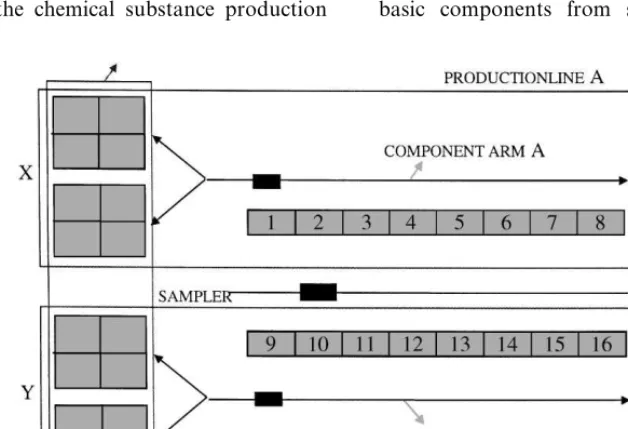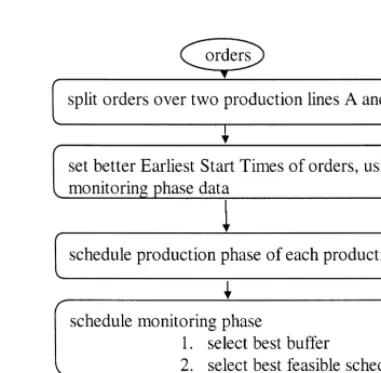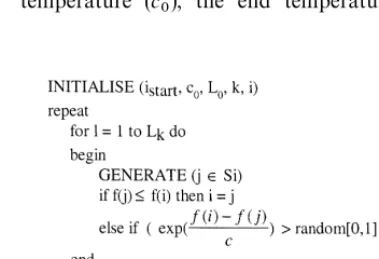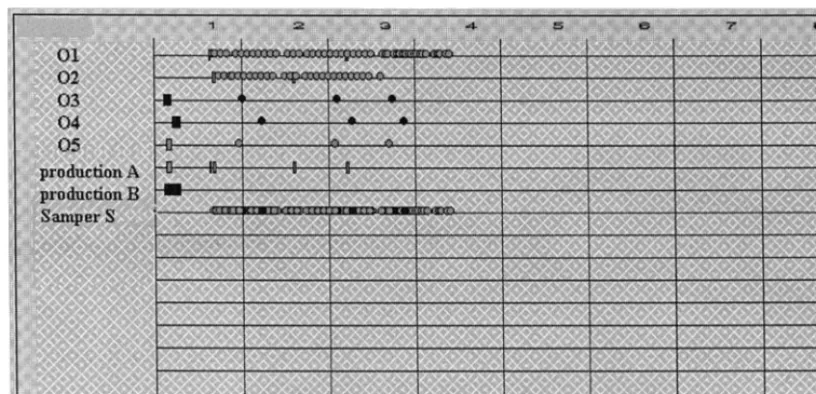*Corresponding author.
E-mail address:[email protected] (P. Van Bael).
A practical decomposition approach for a chemical substance
scheduling problem
Patrick Van Bael
*
, Marcel Rijckaert
Departement Chemische Ingenieurstechnieken, De Croylaan 46, B-3001 Heverlee, Belgium Received 24 June 1998; accepted 1 November 1999
Abstract
This paper describes a decomposed iterative improvement scheduling algorithm developed to solve a scheduling problem of a chemical substance production machine. The algorithm has to determine the most e!ective schedule to produce several chemical substances. In order to build optimal feasible schedules a hybridization of AI techniques (heuristics, simulated annealing, constraint propagation) is used in a practical algorithm architecture. The algorithm architecture is compared against human schedule generation and a simple opportunistic algorithm. ( 2000 Elsevier Science B.V. All rights reserved.
Keywords: Scheduling; Decomposition; Local search
1. Introduction
Many practical scheduling problems do not "t into the simpli"ed scheduling models [1]. The shop models like open or closed job shop models, #ow shop models, one machine problems or multiple parallel machine problems have been described in literature and solved with general or even speci"c algorithms [2}5]. However, these simpli"ed model representations cannot always be successfully applied to the practical speci"c problem detail, which is common for industrial scheduling prob-lems [6]. These probprob-lems usually consist of speci"c constraints which have to be satis"ed and cannot always be modeled and solved through the use of
one single global method [7]. Hence, one tries to solve large real-world scheduling problems by us-ing modular algorithm structures or architectures. Two elements are important in modular environ-ments:
f Hybridization: the use of di!erent techniques combined in the same architecture to solve the same task;
f Specialization: the combination of di!erent mod-ules using a similar technique for solving di! er-ent tasks.
Modularity simpli"es large complex tasks into a set of small, connected and manageable sub-modules, which can be solved separately whilst reducing complexity and development time.
Within a framework one can combine di!erent (types of) scheduling techniques together with
arti-"cial intelligence techniques or even operational
Fig. 1. Production layout.
research techniques. The scheduling optimization problem of a chemical substance production machine can also be solved with the use of a more complex architecture.
In Section 2 the problem is described; Section 3 focuses on the algorithm architecture to solve the scheduling problem and Section 4 shows the pre-liminary results accomplished with this algorithm architecture. Section 5 concludes with a discussion on these results.
2. Problem description
Every day a certain demand of chemical substan-ces is requested. The request is speci"ed with a spe-ci"c order recipe to produce the chemical substance needed. The scheduler brings these orders together and tries to make a feasible and optimal schedule for the chemical substance machine.
The di$culty to make a feasible schedule comes from the many constraints which are de"ned by the chemical substance machine and from the chemical substance itself. The types of constraints for the machines are the common capacity constraints (limited resources) and the di!erence in time resolu-tion between the chemical substance producresolu-tion
phase and the following monitoring phase. The capacity constraints are the number of orders that can be scheduled during one day, the amount and number of components that can be added, the limited resources to handle the activities to add a certain component and the single shared monitoring machine. The most important con-straint for the chemical substance is the duration of storage. During the production phase the actions representing components to add must be exactly like that speci"ed in the recipe, while the sample procedures are allowed to be scheduled slightly di!erent from the setpoint positions de"ned in the recipe.
2.1. Production layout
Fig. 2. Recipe: di!erent references (K: production phase;¸: monitoring phase), duration of an action (t
1:"ll procedure,t2: sample
procedure,t
3: EST slack time) and possible bu!er size (b) which moves the whole monitoring phase.
Fig. 3. Algorithm architecture.
B from Y). The monitoring machine S can take samples from every substance but only from one substance at a time.
The order recipe consists of two phases (see Fig. 2). The"rst phase produces the chemical sub-stance while the second describes the monitoring procedure. The production recipe consists of com-ponents to be added. Each component has two time speci"cations. The"rst is the time period to wait after a chemical substance started production (K) and the second speci"es the duration to add the speci"c component (t
1). The monitoring recipe
de-"nes the amount of samples to be taken from the chemical substance together with time indications to start each sample procedure. These time indica-tions are relative towards the end of the production phase (¸).
2.2. Production recipe
The simple recipe illustrated in Fig. 2 shows the periods where the chemical substance is altered by the addition of new components. Here, the sample periods only take place after every production step has been performed. All sample procedures within the monitoring phase can be moved all together within the bu!er period (b). The possible move-ments of the individual sample procedures are also shown (t
3).
3. Algorithm description
The algorithm is principally developed to obtain feasible schedules, which is the main di$culty of the problem, and in the second place to obtain an
optimal schedule. The problem described is already simpli"ed because the number of orders is already limited to the maximal capacity a priori known. The remaining problem therefore is to"nd a feas-ible schedule for one day developed with the given orders.
Fig. 4. Simulated annealing algorithm.
The second sub-module is created to avoid that the monitoring machine is not able to function without violating the sample constraints for every order. Therefore, every order is assigned an earliest start time (EST) for the monitoring phase. The module uses a simulated annealing al-gorithm and starts with all orders which are as-signed a zero earliest start time monitoring phase. These earliest start times are the begin points from a discrete timeline. The algorithm disturbs the earliest start times one at a time. After every perturbation the simulated annealing algorithm evaluates the cost function which counts the occupation on every discrete period. At the end of a simulated annealing run the orders have an earliest possible start time where no discrete period has an occupation of samples which exceeds 100%.
A second cost function is also created where a prede"ned occupation is used to set the earliest start times as to achieve this occupation.
The third sub-module schedules the production phase of the orders by using the earliest start times of the monitoring phase as the earliest start times for the production phase. A simulated annealing algorithm is used here, where the cost function is de"ned as the earliest completion time of the latest production phase of all orders (i.e. the minimal makespan). This sub-module is used once for every production line.
The fourth sub-module schedules the sample procedures of all orders with the complementary information of the already scheduled production phase. The sample procedures are scheduled in two phases. The "rst phase tries to "nd an optimal bu!er for every order. This bu!er de"nes the distor-tion from the earliest start time after the producdistor-tion phase. The procedure starts with all bu!ers set to zero. The algorithm, again a simulated annealing algorithm, alters the bu!ers between zero and the maximal bu!er value for one order each time. The cost function is an evaluation of the distortion of every sample start time from its earliest possible start time. In the second phase a simulated anneal-ing algorithm tries to"nd the optimal sample start times using the previously de"ned bu!er possibili-ties. This time the cost function is the earliest com-pletion time of the latest monitoring phase of all
orders and the distortion of every sample start time from its earliest possible start time.
Whenever a schedule is built, a partial or even a whole schedule, a generative schedule construc-tion algorithm is used together with constraint propagation techniques [8]. This means that after every assignment of a start time of a production/ monitoring action the constraints are updated. With this strategy no single action will overlap another action and no single action will be assigned a start time which will cause a backtrack procedure at the end of a schedule generation.
The simulated annealing algorithm is used in di!erent modules. A general description of this algorithm can be seen in Fig. 4 [9] and has already been used several times with success in di!erent domains [7,10,11].
Simulated annealing is a near-optimal stochastic optimization algorithm and is based on a simula-tion of a natural optimizasimula-tion process, i.e. the annealing (cooling down) of a liquid metal to a solid metal with a minimal energy level. This physical process can be achieved by gradually lowering the temperature, giving atoms (of the metal) enough time to rearrange themselves into an equilibrium state at each temperature. Hence, an nealing helps the material to avoid local minimal energy states and to"nd the global minimum en-ergy state.
Simulated annealing as described in Fig. 4 is an analogy of the physical annealing process. It con-sists of a few general parameters like the initial temperature (c
Fig. 5. Cost function of the simulated annealing algorithm of sub-module four.
Table 1
Results of the new algorithm against an opportunistic algorithm
Algorithm Makespan Disturbances
Opportunistic algorithm 6 h 07 min 68
New algorithm: 5 h 41 min 38
New algorithm with occupation in cost function:
90% 5 h 01 min 15
temperature decrement function (CALC(c k)), the
equilibrium de"nition (¸k) and a few special para-meters like the perturbation mechanism (GENER-ATE) and the cost function (f) used. The simulated annealing algorithm used in the di!erent sub-mod-ules only di!er in the special parameters like the cost function and the perturbation mechanism. Although the general parameters do have other parameter values, the structure of the algorithm is identical. An example of the cost function is given in Fig. 5. Here the cost function of the simulated annealing algorithm in sub-module four is given and shows that only optimization terms are used. The perturbation mechanism used is always SWAP, which is a well known mechanism in per-turbations of sequencing structures. The simulated annealing algorithm was already successfully applied in [12].
The algorithm architecture can be seen as a spe-cializing modular architecture. The use of this modular strategy makes it possible to de"ne a sub-set of possible feasible solutions where the number decreases from sub-module to sub-module. The last sub-module tries to obtain the optimal feasible solution. Within every module the parameters can be optimized for a speci"c task. The di!erence between such a strategy and a single algorithm, which tries to optimize the problem with one cost function, is that no search time is wasted with the creation of unfeasible schedules. The last sub-mod-ule should thereby have a simpler task to "nd an optimal schedule since the number of feasible solu-tions is already limited to a small subset. Also, in the past a lot of single algorithms have failed because it is very di$cult to obtain a schedule which is feasible and near-optimal when one tries to optimize both at the same time.
4. Test results
The algorithm architecture is applied to a practi-cal set of orders. Various experiments were performed. In Table 1 the results are represented.
Fig. 6. Illustration of a schedule showing production phases with"ll procedures (rectangles) and monitoring phases with sample procedures (circles).
This comes from he fact that a very low occupations is impossible to schedule over one day, and therefore the system sets the earliest start times almost at the beginning of the day. This explains the low makes-pan and the high disturbance factor for the sample procedures. The lowest possible occupation with-out this phenomenon was 60% in this case.
The schedule generation time over human sched-ule generation time is drastically decreased. A human scheduler was busy for one day to generate a schedule of equal quality as an opportunistic algorithm, where the new algorithm architecture took only 3 minutes on average to achieve the illustrated results on an HP pentium Pro 180 MHz. Fig. 6 shows a schedule which was created by the above-described algorithm.
5. Conclusion
In this paper, a modular algorithm architecture is developed which was used to solve the scheduling problem of a chemical substance production ma-chine. The algorithm is a decomposed iterative im-provement scheduling algorithm consisting of several modules. Each module optimizes a smaller sub-problem focusing on a speci"c constraint and
resulting in a set of feasible solutions. The last module searches the optimal solution from a lim-ited set of feasible schedules. With this algorithm preliminary results have shown that it is possible to solve a scheduling problem by focusing on speci"c di$culties of the practical scheduling problem. The new algorithm's performance is an improvement over human schedule generation time and over simple opportunistic algorithm results.
Acknowledgements
This work was"nanced with a fellowship form the Flemish Institute to Improve the Science-Tech-nological Research in Industry (IWT)
References
[1] M. Zweben, M. Fox, Intelligent Scheduling, Morgan Kauf-mann, Los Altos, CA, 1994.
[2] K. Baker, Introduction to Sequencing and Scheduling, Wiley, New York, 1974.
[3] M. Pinedo, Scheduling: Theory, Algorithms and Systems, Prentice-Hall, Englewood Cli!s, NJ, 1995.
[5] T.A. Ciriano, R.C. Leachman, Optimisation in Industry, Wiley, Chichester, UK, 1993.
[6] C. Dockx, K. Meert, Production scheduling in a chemical process environment based on a simulated annealing algorithm, Beaelux Quarterly Journal on Automatic Con-trol 34(3) (1993).
[7] V.J. Rayward-Smith, I.H. Osman, C.R. Reeves, G.D. Smith, Modern Heuristic Search Methods, Wiley, Chichester, UK, 1996.
[8] P. Van Bael, Scheduling chemical batch processes with transfer times and sequence dependent set-up times in ZW
or NIS policy, Proceedings of the Second Conference on Practical Applications of Constraints Technology, 1996. [9] E. Aarts, J. Korst, Simulated Annealing and Boltzmann
Machines, Wiley, Chichester, UK, 1989.
[10] V. Rayward-Smith, Applications of Modern Heuristic Methods, Waller, Henley-on-Thames, 1995.




